Alongside the general increase in interest in tabletop gaming, the historical wargaming hobby has taken significant strides in the last several decades and is illustrated both by the changing mechanisms of play and designers’ conscious appeal to wider audiences. Both wargame and wargame-adjacent games have taken a leap forward since titles like Advanced Squad Leader, Panzer Blitz, and lighter fare like Risk and Axis and Allies first appeared on game shelves.[1] Wargame and wargame-adjacent games released in the last twenty years have evolved significantly both in terms of play mechanisms and representation for traditionally marginalized groups.
These innovations are due to the conscious decisions of modern game designers. This study, based upon an email survey, features ten current historical wargame and wargame-adjacent designers: Beau Beckett, Tory Brown, Glenn Drover, Larry Harris, Mark Herman, Jason Matthews, David Thompson, Jeph Stahl, Maurice Suckling, and Grant Wylie. The study considers responses from the designers on three topics: how have game mechanisms changed from simple dice-rolls representing battlefield combat to more innovative systems; how do designers present historical accuracy in their designs, and do they engage in historical distortions (“fudging”), in the interest of more balanced gameplay; and finally, what are the designers’ views on the representation of traditionally underrepresented groups in the games. The purpose of this study is to understand current designers’ perspectives on these issues, and how they may resonate throughout the hobby and the wider culture.
The Designers, Their Games, and the Evolution of Game Design
In considering the evolution of modern wargame mechanisms, Mark Herman, designer of such games as Churchill, Fire in the Lake, Fort Sumter, and ninety-two others, notes his 1992 game We the People.[2] The game zoomed out the scope from simple tactical and operational engagements. He stated that with this design, he “integrated the political and military dimensions of conflict into a common mechanic as I wanted to place the gamers into the mindset of the Continental Congress or King George IIIrd’s senior leadership.” Players take on specific roles and groups “rather than an overarching deity running the war.” The game, which uses card mechanisms as well as dice for events and combat, was expanded upon in his 1998 wargame, For the People, in which players take on the roles of Abraham Lincoln and Jefferson Davis. Because the players assume these roles, “the cards define and limit your decision space.” This card-driven mechanic was also used in Herman’s 2005 Empire of the Sun, in which the players take on the roles of Pacific theater commanders in the Second World War.[3]
Jason Matthews, designer of twenty titles such as Twilight Struggle, 1960: The Making of a President, and Imperial Struggle, also cites Herman’s We the People as groundbreaking.[4] “Prior to … We the People, politics was represented in wargames as … a static set of contingent rules = if X then Y happens. Or worse, as a set of random events generated by chance as if politics were an alien force dropping lightning bolts on military decision making instead of as two sides of the same coin as Clausewitz aptly described.” Matthews noted that card-driven games (CDGs) allowed for more nuance and the contextualization of politics. Also, they create “more realistic interplay between political decision makers and military commanders.”
David Thompson, designer of over forty games including Pavlov’s House, War Chest, and Resist!, created a fusion of squad-level wargame and a modern deck-building mechanism from the larger board gaming hobby for his Undaunted Normandy and subsequent series of games.[5] “Ultimately the choice of using deck-building as the core mechanism in the game was an abstraction [that] I chose because of how well it can simultaneously model command and control, fog of war, tempo, and attrition,” Thompson noted. “When taking on the role of the platoon commander, a player has the agency to both drive their strategy (that is, the way they attempt to achieve their goal through their overall plan, to include their deck-building choices) as well as their tactics (the choices they make on each individual turn).”[6]
Grant Wylie has designed over seventy titles such as Hold the Line, Bismarck Solitaire Deluxe Edition, and The Seven Days Battles, and also considers Herman’s We the People as an important step forward in wargame design.[7] He notes the card combat system from We the People, a system that has players playing matching cards representing military tactics until one player or the other can no longer play a matching card. “We used that classic card combat system in our own Napoleon 1815 where the number of combat cards you were given was based on combat strength and terrain.”[8] Despite the evolution in game design, Wylie still finds that he enjoys older games where combat results tables were common. “I keep trying to be more inventive myself but being an old school player, I tend to enjoy CRTs [Combat Results Tables]. Even with CRTs the nice thing now is that designers have gotten more inventive by rolling 10, 20, and more dice.”
With twenty-four game designs to his credit, Larry Harris, designer of the original Axis & Allies and subsequent series of games, notes the evolution of his World War II design with the release of War Room.[9] “I think the simplified secret movement system used in War Room brings to the players the challenge of dealing with the unknown. Which of course plays a major role in military history and the simulation of historical wars.” In War Room, players write down their order movements and then reveal the orders simultaneously, a mechanism that had existed as early as Diplomacy, but here including a bidding system, using oil as the currency.[10] Harris also included a National Morale Track, “that translates losses and bad war time developments into reducing a player’s ability to wage war.”[11]
Tory Brown’s first game design, Votes for Women is a wargame-adjacent game that details the women’s suffrage movement in the United States.[12] The game uses a cube influence mechanism similar to Matthews’ Twilight Struggle. However, she notes, “Votes for Women transforms cubes into political power that players build in the forty-eight states over six turns.” Card play, based on historical events, triggers decisions for cube placement. “The design articulates a more complex yet accurate version of the history than many of us learned in school.” Several factors, include a Congressional track, “mimic the suspense during the [19th Amendment] ratification period.”
Jeph Stahl and Beau Beckett, designers of fifteen and twelve games respectively, have created the Birth of America system of games, which include 1812: The Invasion of Canada, 1775: Rebellion, and 1754: Conquest – The French and Indian War.[13] Stahl notes that these modern area control games were inspired by Risk and Axis & Allies. Like those games, the Birth of America system relies on a dice combat mechanism, but for this game the dice sides are altered. “A key component that we came upon is to have only two symbols on the dice,” he stated. “This way players could instantly see the results without any hesitation.” The dice boast a blank side that allows players the option of retreating units, another side that features a “flee” symbol, meaning the player’s own units leave the current combat, and a “hit” symbol, meaning the opposing player has sustained a casualty. The dice sides are also influenced by the games’ factions, which could field more or less effective units. “Each faction has a customized set of dice that portray how that faction would function in battle,” Beckett stated. “This system also simplifies game play by eliminating lookup tables and charts. When you roll the dice, you instantly know whether to laugh or cry.”
Glenn Drover has designed over fifty games, including The American Civil War, Age of Empires III: The Age of Discovery, and Mosaic: The Story of Civilization.[14] He commented on the evolution of games systems generally in recent years. “They have evolved to reduce luck, and reward good decisions and planning. They have evolved to allow the player to impact the outcome by modelling good tactics, logistics, and strategies.” Drover noted that he seeks to incorporate these ideas into his game designs. He cites his game, Victory & Glory: Napoleon.[15] “The French player is rewarded for aggressively growing his empire and army to expand his influence while not ignoring his economy. They must also balance recruiting effective, but costly French troops vs. filling out their ranks with less dependable allies.” Drover states that his system rewards players for effectively maintaining the balances within the game, rather than playing out a scripted historical scenario. “This means that the player can attempt to re-write history while still being constrained by what was historical possible.”
Given designers’ various new approaches to wargames and wargame-adjacent games, it is little wonder that the hobby, while still a distinct niche in the wider world of tabletop gaming, has become more popular with the general public. As designer Maurice Suckling has noted, larger player counts, shorter play times, less complex and less dense rules, and moving away from traditional hex-based systems are all factors as well. Further, expanded government funding for programs involving wargames has been on the rise, as institutions such as the Center for New American Security and the Warfighting Lab Incentive Fund compliment the Pentagon’s traditional interest in wargaming possible future military scenarios. This increased governmental interest has also almost certainly trickled down into the public consciousness as well. The result of these factors goes a long way toward explaining the new popularity for the wargaming hobby.[16]
How Do Designers Present History in Their Games?
In designing historical wargames, each designer must be something of an amateur historian. However, for games based on actual people and documented events, the possibility that historical accuracy may lead to an imbalanced game is always a possibility. The survey included questions asking if the designers had ever consciously “fudged” history in the hopes of creating better game play balance.
Suckling, designer of Freeman’s Farm 1777, Chancellorsville 1863, and Hidden Strike: American Revolution, provided an ambiguous answer.[17] “I will note that historical accuracy hasn’t been knowingly or deliberately fudged in my designs, and that, at the same time, it is also always unavoidably and fully consciously fudged.” He explains this by stating that his designs must present “plausible processes and resultant narratives,” and anything that does not accomplish this is a failure. By the sheer number of combinations of possible counterfactual outcomes, most games do in fact, “fudge” history, he contends. Further, he states, “anything that pulls the focus of history back onto its contingent quality is perhaps a higher form of historical accuracy than the co-incidence of events in a game with chronological and spatial counterparts on the historical record.” In this view, the nature of any game that allows for ahistorical decisions is, by default, a game that has “fudged” history.
Suckling cites his game, Hidden Strike: American Revolution. The game contains a hidden traitor mode that allows one of the American founding fathers, including George Washington, to be a traitor in the manner of Benedict Arnold. “Clearly this is historical nonsense. But within the context of a very light wargame that has a hidden traitor mode as a central mechanic this seems admissible to me.”
Castle Itter presents an incident at the end of the Second World War in which the U.S. Army and elements of the German Wehrmacht fought together against Waffen-SS troops to defend a fortress containing high-ranking French prisoners.[18] Thompson, the game’s designer, states that “occasionally, I have adjusted the outcomes of a conflict to provide more tension for the players.” Major Josef Gangl, the Wehrmacht commander, was the only casualty of the battle. “The player takes the role of the defenders and must hold out against attacks from the SS. I increased the likelihood of causalities among the defenders to increase tension for the player.”
Some designers do not like to consciously fudge the history they present in games. Wylie maintains that he attempts to remain as faithful to the historical record as possible. “I don’t like fudging history. I am one of those ‘play it as it lies, no mulligans’ guys.” Further, he doesn’t appreciate games that attempt to weigh down the player with excessive rules exceptions in order to represent every aspect of the history. “I despise game systems – particularly series games – that have an overload of special rules for games due to the situation. If a series’ rules can’t apply to every situation in a series, then the rules aren’t right in my opinion.” Herman likewise dislikes the idea of “fudging” history for the sake of balancing. “I am a historian who uses published games as my main channel for illuminating history verses book authorship. The concept of ‘fudging’ history never occurs to me and is never a component of any of my work.” However, he notes that his games are entertainment, and compares a CDG scenario to the way documentary filmmakers like Ken Burns present small, episodic vignettes for their films. “A documentary film is relating a perspective on an established timeline of facts that cannot vary from what is known. A wargame is an expression of those same facts as a plausible ‘alternate’ history.” He states that such a view illustrates the historical event and recorded timeline as it was, but also presents options to plausible possibilities.
Games can also be a medium to present facts in a manner that disentangles sometimes muddled history. Brown asserts that Votes for Women attempts to “unfudge” history by combating common historical myths. She states that the history of the women’s suffrage movement largely ignored activists such as Lucy Stone, as well as women of color. The common myth “advanced a simplistic narrative of a single, successful effort toward suffrage while the reality was far more nuanced and even adversarial.” The game presents women “from all walks of life, driven by all manner of ideology, and infected by bias and limitations that were pervasive during the time period.” The two players in the game, which represent the suffragettes and the opposition to the movement, each boast card decks divided into three smaller decks, depicting “early, middle, and late” eras. Within each era, historical events can play out in an unchronological manner, such as Reconstruction occurring before the Civil War. However, some card events can only be triggered if other, prior events have occurred. “The way cards fit together but still allow for unique series of events to unfold is part of what I hope makes Votes for Women as engaging as it is educational.”
Stahl notes that he and Beckett have not created simulations, but rather playable wargames. “We concentrated on the level of abstraction that when played, players would find situations that did not occur in history,” he stated. “Abstraction continues in how we represent our units. Is a cube a group of men? A single man?” However, Beckett asserted that historical accuracy was important to the development of their Birth of America series of games. “We knew that the players would be looking for any little errors in our history so we kept it as accurate as we could while still having a playable game.” Further, Beckett related that some historical accuracy had to give way to balance. “One thing that was loosely interpreted to make the game balanced and playable was the number of units each faction had … to make the game work quantities of units had to be adjusted and tested.”
For Age of Empires III: Age of Discovery, Drover asserted that he found some historical inaccuracies necessary. “I fudged the timing and relative power of the European colonial powers to achieve a balanced and equal starting point for the contestants. I did this for play balance, and also so that the players would each be free to experiment with different approaches and strategies in building their colonial empires.” He noted that if he had stuck to the actual relative strengths of the powers, the result would have been a loss of options for the player, and a scripted scenario that unfolded as history actually did. Drover added, “one of the greatest values of simulations, is what can be learned about the events by examining the decisions and the outcomes for those who made them (and for those affected by them).”
Matthews explicitly states that balance trumps historical accuracy in his designs. “I always sacrifice history for playability when necessary. But equally significantly, I do so if nuance gets in the way of the narrative I’m trying to convey.” He likens the process to that of a kabuki play. “The makeup and gestures are so dramatic so they can be seen all the way in the back. The same thing is true when expressing history through the medium of a game. If you muddle the story with too much nuance, the detail swallows the larger point.” He notes that even though the domino theory, the idea in Cold War geopolitics that a nation state’s shift toward Communist or democratic politics can cause a similar shift in neighboring states, can be “largely and demonstrably false,” the concept is a foundation of Twilight Struggle’s game play. “Similarly, in Imperial Struggle, we downplay other great powers in a multipolar world – like Spain and Holland to focus players on the one-hundred-year rivalry between Britain and France.”
While historical distortion can be necessary to serve the game’s narrative, Matthews also observes the importance of sometimes abstracting more unpleasant aspects of warfare such as “war crimes, cruelty, slavery, literal raping and pillaging.” He states that “the truth is our defense. Historical simulations are incorporating these tragedies because they happened, and it’s important to understand why, and how they might have been prevented.” It’s also important because it helps players to understand whether what happened was the “actual worse case. Did we avoid it? Could things have been even more bleak than the status quo? When we fudge to make a political point, we abandon this defense.”
Finding the right balance in how history is presented in a game can be challenging. Harris states that, “to be historically on target is a good thing to strive for. I can’t always get all the history I want, but I can always get all the history I need.” However, he also remarks on the delicate balance between accuracy and playability. “When it comes to war games there is always a tradeoff between history and playability. It is for me the designer to find the level/depth I need the game to be at. Once that level is determined it must be consistent throughout the game and reflected in the game components.” He asserts that his game Axis & Allies “does not pretend to be Churchill’s wartime biography.” Accuracy, he contends, comes with baggage that must be accounted for – the exceptions and special rules that Matthews and Wylie reject. “It is important to emphasize the important, the obvious, the well-known aspects of a given theme.” Critically, the balance must be maintained. “Being a game, all the competing players should have the same prospects of winning the game. If they don’t have the same winning objective, they should at least have one that is as difficult, or as easy, as the opposition has.”
An example of “fudging” the history in order to provide more balance can be found in Harris’ World War II era game, War Room. In the game, players use oil as a form of currency for buying military units and for bidding for initiative in the secret orders phase. Many geographical regions on the board have printed oil resources, and the nation that owns that region has access to them. The region of Libya is listed as having two oil resources, which contribute to the Axis players’ reserves from the beginning of the game. However, oil drilling did not begin in Libya until the late 1950s – over a decade after the conclusion of the Second World War. “I stand by that red two resource in Libya,” Harris stated. “I desperately need all the accessible red resources I could find for game play balance purposes.”[19]
“Fudging” history, it appears, is a matter of perspective. Given the fact that every game rooted in history must have variable outcomes, while history itself is immutable, one could argue the medium by its very nature is ahistorical. And yet there are times when the history presented in the game itself is distorted in some manner, such as War Room’s two oil resources in Libya. Unlike academic historians, who use well documented research and factual information as the bedrock of their works, and any intentional historical errors or distortions can negatively impact their reputation, wargame designers have more freedom to sacrifice facts in the interests of playability and balance. Indeed, as Matthews argues, abstraction is often key, and history in games must often be simplified for the medium. While some designers may attempt to stick as closely to the historical facts as possible, the necessity of abstraction will always mean wargames will “fudge” on some level. Just as importantly, designers can also uncover previously muddled history in the manner of the academic historian, such as Brown’s attempt to portray the women’s suffrage crusade as a multidimensional movement.
How are Wargames and Wargame-Adjacent Games Becoming More Inclusive and Diverse?
The final survey questions considered matters of representation for traditionally under-represented groups in modern wargames. Brown takes a wider view of the issue and reflects that “every history book you’ve ever read is fudged because we simply can’t include every voice and every perspective. Similarly, game designers should feel empowered to tell the story, create the narrative and make the game that aligns with their values and their voice.” Brown believes that her approach to Votes for Women is an attempt to “correct the record” rather than fudge it. She illustrates this by including the various historical figures, debates, and contention within the women’s suffrage movement, rather than focusing on a simpler and more easily digestible historical narrative. “If the game continued the myth that a few women accomplished so much on their own or with minimal conflict, it would be a lot less compelling.”
In considering the current willingness in the industry to include traditionally underrepresented groups in wargames, Brown states “more people are realizing that respecting diversity and reflecting shared values makes for more interesting storytelling. It allows more players and cultural consumers to see themselves in the works and it empowers all of us to see our shared humanity across intersecting identities.” She asserts that as publishers create more games that reflect these issues, a more diverse community will be drawn to the hobby. It is, she states, “truly a virtuous cycle of creation and competition all made possible by representation.”
The previous lack of diverse representation in the hobby most likely reflects defects in the historical record, according to Suckling. “I suspect … that underrepresented groups participated in ways the systems created failed to account for, because the source material … omitted them. This is what makes them underrepresented.” Further, he notes that the importance of representation hasn’t changed, sees the merit from a marketing perspective, and “the possibility of growing the hobby into hitherto untapped demographics.” However, he states that such representation is not important simply for marketing purposes, but because of wider social benefits. “Without hearing these voices, we are restricting our exposure to humanity, and under-utilizing the confidence and perspectives that might benefit our society as a whole that can come from these under-represented individuals and communities.” He also offers the idea that the new perspectives being included in modern wargames are not being created “by force of ill-conceived good intentions that distort the reality of history.” Rather, modern designers are shedding light on history that previously had been forgotten or suppressed.
Matthews believes that questions of representation are more important now than in the past. “Because the hobby is happily diversifying, people expect their history to be covered in historical games.” He wonders whether most wargamers are genuinely interested in history, “or rather are more interested in the comfortable fables of white male heroics that they have always heard.” He notes that there are only a few wargames that tackle intra-African wars, “but there will be multiple titles published on Gettysburg every single year, and… someone like [Erwin] Rommel is perennially lionized.”
The question of whether diversity is more important now than in the past is more subjective, according to Herman. “I believe all factors relevant to the historical event that you are portraying are important.” In his game Churchill, Herman comments that he treated U.S. Secretary of Labor Francis Perkins, the first female cabinet member, no different than other leaders the game includes. “My point is that if you focus on the history and simulate the events correctly the representation of gender is easy to handle, such as covering Boudicca’s defense of ancient Britain.” He also notes that many of his games set in the ancient world contain many different peoples and cultures and again are presented based on what happened historically. “My take is that how race and gender are being portrayed is no different than it was in the past. What I do see is there are far more titles being published around the history of political protest that appropriately deal with the nuances required to tell their story.” He asserts that it is not the portrayal of underrepresented groups that has changed. Rather, there are simply more titles covering these groups that are being released.
Further, Herman considers that ignorance of history can sometimes lead to unnecessary controversy. Artist Rodger McGowan designed the cover art for Herman’s original Empire of the Sun, which featured Japanese soldiers aggressively charging. “There was an immediate reaction from some saying that it was a racist portrayal of Japanese soldiers.” In fact, the graphic had been used by the Japanese themselves as propaganda during the Second World War and had hung on the side of a tall building in Tokyo. The controversy died down after this fact was revealed. “This story illustrates that portrayals of society and culture are touchy subjects for many.”
“I take more liberty in the inclusion of traditionally underrepresented groups,” declares Thompson. He notes that the cover for Undaunted: Normandy featured both white and African American soldiers on the cover. “This type of representation has elicited an extremely strong backlash from a loud section of the gaming hobby, who argue that this type of representation is ahistorical. This issue with many of these claims is that they are grounded in ignorant constructs of history that have been perpetuated.” The issue stems from claims that U.S. Army platoons had not been integrated in World War II. However, Thompson notes that some units did begin to integrate in Europe not long after the Battle of the Bulge. He does concede that the 30th Infantry Division, which is represented in the game, did not include African American soldiers, and that no units were integrated during the Normandy campaign, which the game covers. However, Thompson asserts, “these are not the arguments being made by those who oppose the game’s representation; their objections are based on a much boarder, and incorrect, assumption about the historic record.”[20]
Thompson’s take is similar to Herman’s in that he believes the importance of representation in gaming is nothing new, but we are now seeing a lot more games published that feature underrepresented groups. “We are now starting to see a community that is supportive of improving representation in gaming, both in terms of the players of the games and in the games themselves.” He applauds the current trend toward representation. “It’s part of the hobby’s discourse now, and that is a very, very good thing for the historical and wargame hobbies, as well as the broader gaming hobby.”
In contrast to Thompson, Wylie comments that he would not fudge the historical record to include underrepresented groups. “I personally feel that to do that would be disrespectful to the participants at the time and the group I would be putting in. If a group did not participate at the time due to race or gender it was through no fault of theirs, but the ignorance of the people at the time.” Wylie’s Civil War games present historically accurate units, with a few brigades featuring African American soldiers for the earlier battles. “As I get into the 1864 campaigns… there will certainly be units that were black regiments and brigades. I won’t single them out in the rules, they will be a piece like all of the other pieces.”
Drover remarks that in his game Age of Empires III: The Age of Discovery, “I didn’t give the Native Americans much of an active or interesting role. This was a missed opportunity to explore the potential for an alternative relationship between the colonizing Europeans and the Native Americans.” Still, he notes the opportunities to come with the expanding diversity in the hobby. “I am extremely excited and happy that participants and designers in our hobby and industry are more diverse than they have ever been… Inclusivity and equality are ethical imperatives, but also make for richer experiences for all of us.”
Stahl also believes that diversity and representation has always been important. “But now we are acknowledging the past errors and trying to move forward in a more enlightened fashion. The more we recognize the mistakes of the past the better we can avoid them in the future.” Beckett states that these issues “are definitely more prevalent now than they have been in the past. Years ago, gaming was a very male dominated activity. Now it is happily opened up to anyone who wants to play.”
Wargames certainly have changed over the past few decades, in terms of game play mechanisms, the history that is represented, and in the people who play them. In considering the voices of modern wargame designers, several points become evident. First, wargames have evolved over the past few decades from simple dice rolling combat and God-like overviews of battles and wars, to more nuanced mechanisms that included political objectives with cards, secret information and orders, deck-budling, modern area control, game-specific dice, and more. Additionally, each designer must wrestle with the question of historical accuracy against game play balance and decide just how much to fudge the history in order to create a workable historical wargame, or not fudge it at all. Certainly, the desire to accurately reflect history while at the same time ensuring game balance is not always an easy one, and each designer brings their own approach and abilities to the task, carefully considering all of the factors that they want to include or exclude to make the game work, and hopefully be successful.
Finally, all the designers see merit in the trend toward greater representation in wargames. In considering traditionally underrepresented groups, some designers assert that they are not fudging, but correcting the historical record. Historical perspectives can often be based on myths, incomplete records, and deliberate distortion. The prospect that wargame designers are working to include more diverse voices in their work to combat these perspectives can perhaps help to better educate members of the hobby, and thus offer a positive contribution to society and the wider culture. Harris considers this new cultural trend. “I think America has become more and more open about racial, gender, and sexuality issues… Games will be absolutely caught up in these cultural developments. What could be more cultural than games?”
[1] Don Greenwood, Advanced Squad Leader (Avalon Hill, 1985); Jim Dunnigan, PanzerBlitz (Avalon Hill, 1970); Albert Lamorisse & Michael I. Levin, Risk (Parker Brothers, 1959); Larry Harris, Jr., Axis & Allies (Milton Bradley, 1981).
[2] Mark Herman, Churchill (GMT Games, 2015); Mark Herman, Fire in the Lake (GMT Games, 2014); Mark Herman, Fort Sumter (GMT Games, 2018); Mark Herman, We the People (Avalon Hill, 1992).
[3] Mark Herman, Empire of the Sun (GMT Games, 2005); Herman has written on his design for We the People and the CDG system in his essay, “Empire of the Sun: The Next Evolution of the Card-Driven Game Engine,” which appeared in Pat Harrigan and Matthew G. Kirschenbaum (eds.) Zones of Control: Perspectives on Wargaming (Cambridge: The MIT Press, 2016), 133-140.
[4] Jason Matthews and Ananda Gupta, Twilight Struggle (GMT Games, 2005); Jason Matthews and Christian Leonard, 1960: The Making of a President (Z-Man Games, 2007); Jason Matthews and Ananda Gupta, Imperial Struggle (GMT Games, 2020).
[5] David Thompson, Pavlov’s House (DVG Games, 2018); David Thompson and Trevor Benjamin, War Chest (Alderac Entertainment Group, 2018); David Thompson, Trevor Benjamin, and Roger Tankersley, Resist! (Salt & Pepper Games, 2022); David Thompson and Trevor Benjamin, Undaunted: Normandy (Osprey Games, 2019).
[6] For a closer look at the design process for Undaunted: Normandy, see David Thompson, Design Diary: Platoon Command, Board Game Geek, 12 May 2016, https://boardgamegeek.com/thread/1574688/design-diary?fbclid=IwAR3HreVAW-rIkG5ReC17_BQyKtwQNe9Seu9gqsmFzEe0B4T-rBaetFOJdfc, accessed 19 September 2023.
[7] Grant Wylie, Hold the Line (Worthington Games, 2008); Grant Wylie, Mike Wylie, and Sean Cooke, Bismarck Solitaire Deluxe Edition (Worthington Games, 2023); Grant Wylie and Mark Wylie, The Seven Days Battles, (Worthington Games, 2023).
[8] Grant Wylie and Mike Wylie, Napoleon Returns, 1815 (Worthington Games, 2020).
[9] Harris, Axis & Allies; Larry Harris, War Room (Nightingale Games, 2019).
[10] Allan B. Calhamer, (self-published, 1959).
[11] For a closer look at the concepts behind hidden orders in Diplomacy, see Jon Peterson, Playing at the World: A History of Simulating Wars, People, and Fantastic Adventures, from Chess to Role Playing Games (San Diego: Unreason Press, 2012), 381-386.
[12] Tory Brown, Votes for Woman (Fort Circle Games, 2022).
[13] Jeph Stahl and Beau Beckett, 1812: The Invasion of Canada (Academy Games, 2012); Jeph Stahl and Beau Beckett, 1775: Rebellion (Academy Games, 2013); Jeph Stahl and Beau Beckett, 1754: Conquest – The French and Indian War (Academy Games, 2017).
[14] Glenn Drover, The American Civil War (Eagle-Gryphon Games, 2001); Glenn Drover, Age of Empires III – Age of Discovery (Tropical Games, 2007); Glenn Drover, Mosaic: A Story of Civilization (Forbidden Games, 2022).
[15] Glenn Drover, Victory & Glory: Napoleon (Forbidden Games, 2017).
[16] Akar Bharadvaj, “Building a new generation of wargame professionals with intention: From Avalon Hill to Oregon Trail and beyond,” in PAXisms, 30 June 2023, https://paxsims.wordpress.com/2023/06/30/building-a-new-generation-of-wargame-professionals-with-intention-from-avalon-hill-to-oregon-trail-and-beyond/ Accessed on 22 January 2024; Maurice Suckling, “The Re-Popularization of Commercial Wargames”, Ludogogy, 8 November 2020, https://ludogogy.co.uk/article/the-re-popularization-of-commercial-wargames/ Accessed on 22 January 2024; U.S. Deputy Secretary of Defense, Memorandum for Director, Cost Assessment and Program Evaluation, Warfighting Lab Incentive Fund and Governance Structure, 6 May 2016, https://defenseinnovationmarketplace.dtic.mil/wp-content/uploads/2018/02/DSD_memo.pdf. Accessed on 22 January 2024; United States Accountability Office, Report to the Committee on Armed-Services, House of Representatives, Defense Analysis: Additional Actions could enhance DOD’s Wargaming Efforts, April 2023, https://www.gao.gov/assets/gao-23-105351.pdf. Accessed on 22 January 2024.
[17] Maurice Suckling, Freeman’s Farm 1777 (Worthington Games, 2019); Maurice Suckling, Chancellorsville 1863 (Worthington Games, 2020); Maurice Suckling and Dorian Richard, Hidden Strike: American Revolution (Worthington Games, 2021).
[18] David Thompson, Castle Itter: The Strangest Battle of World War II (DVG Games, 2019).
[19] San José State University, The History of the Development of Libyan Gas and Oil Reserves, accessed 13 September 2023, https://www.sjsu.edu/faculty/watkins/libyanoil.htm.
[20] For more on U.S. Army integration in World War II, see Thomas A. Guglielmo, Divisions: A New History of Racism and Resistance in America’s World War II Military (New York: Oxford University Press, 2021), 328-334.
Appendix
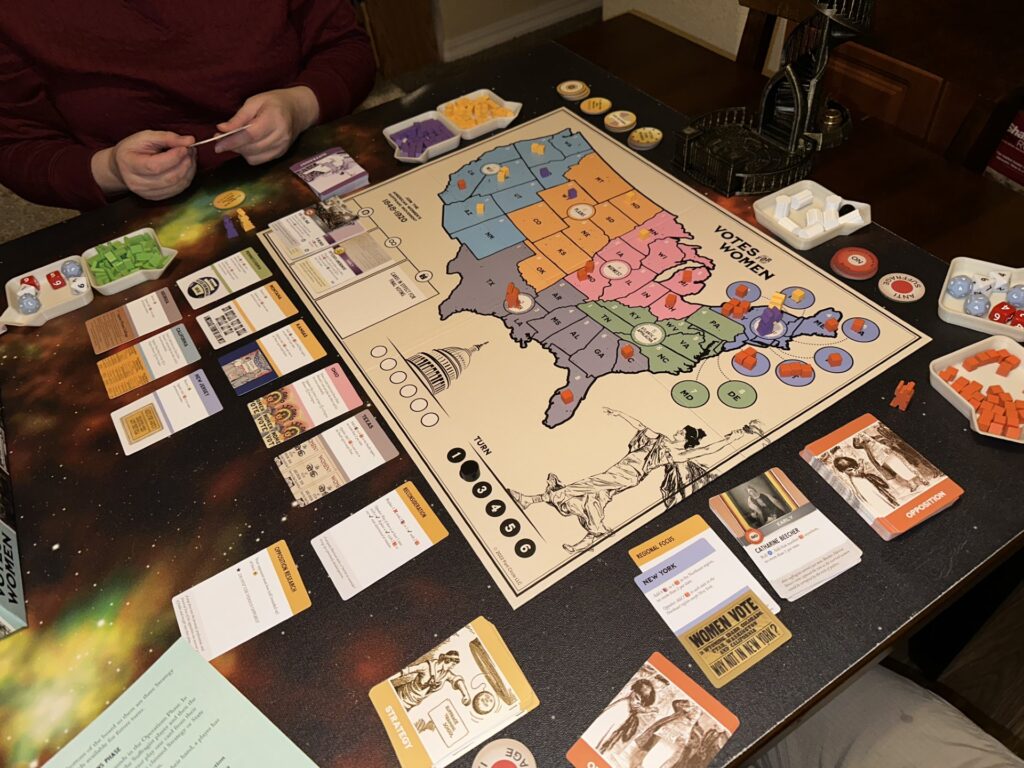
Votes for Women, Tory Brown
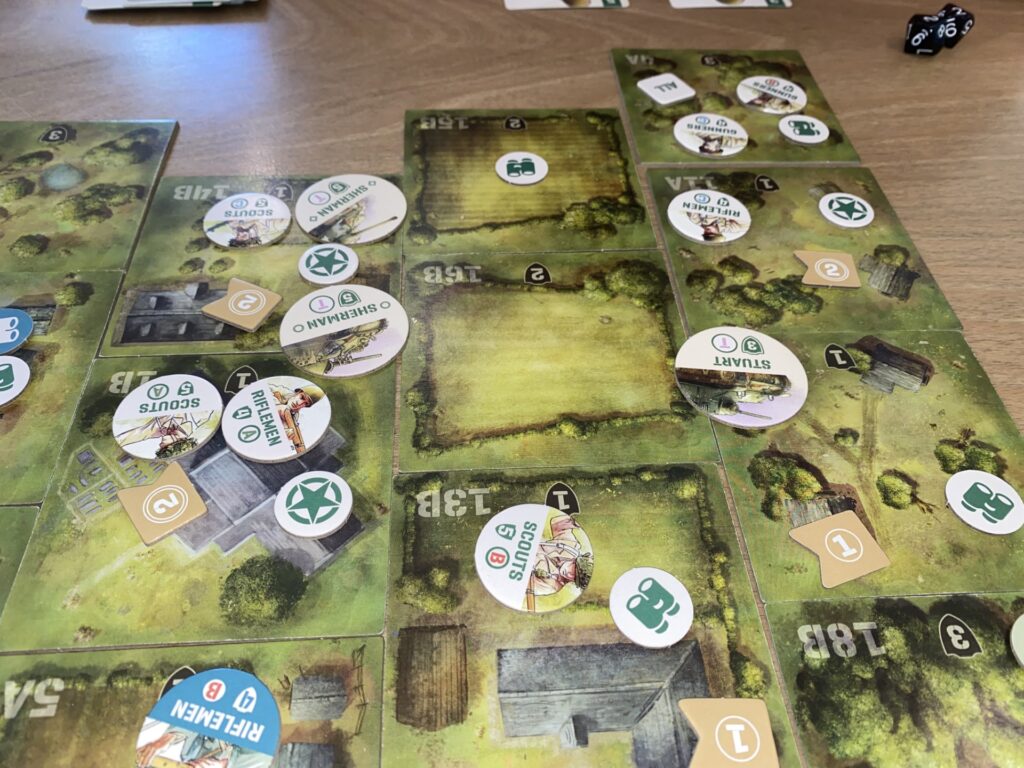
Undaunted: Normandy, David Thompson
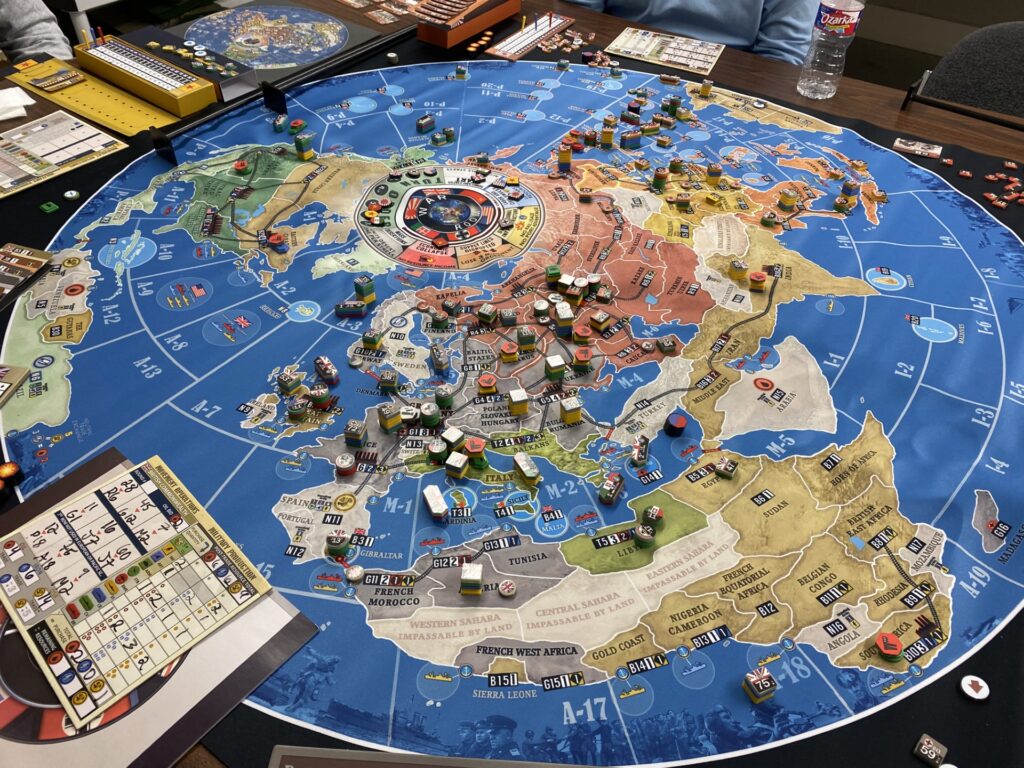
War Room, Larry Harris
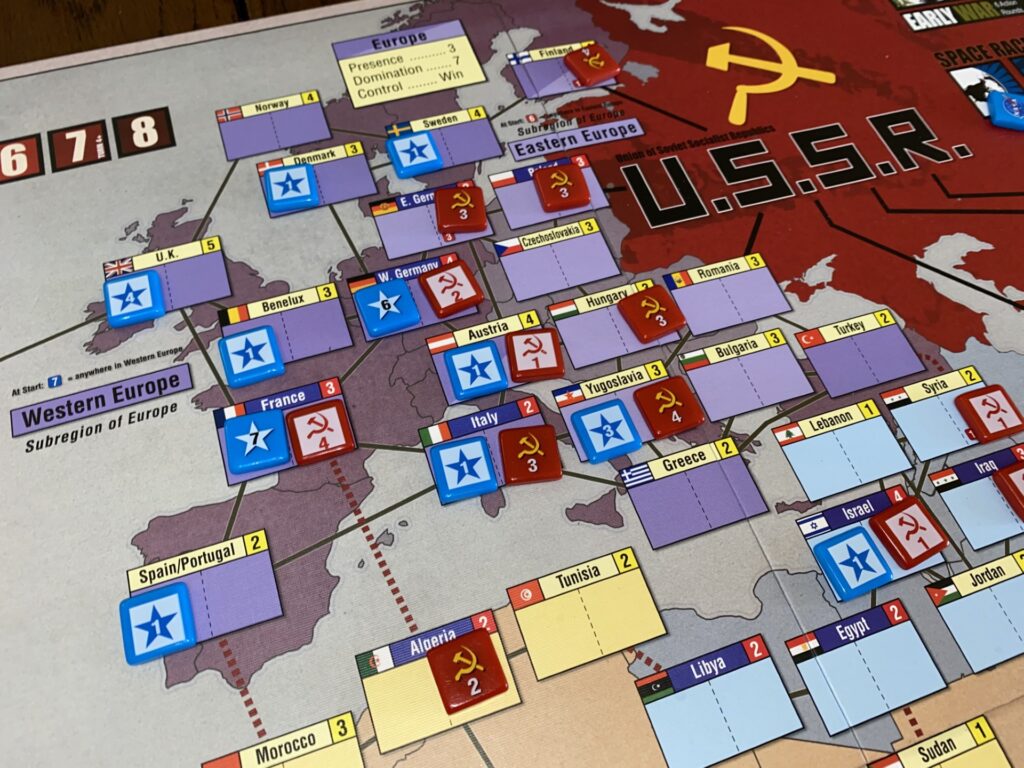
Twilight Struggle, Jason Matthews
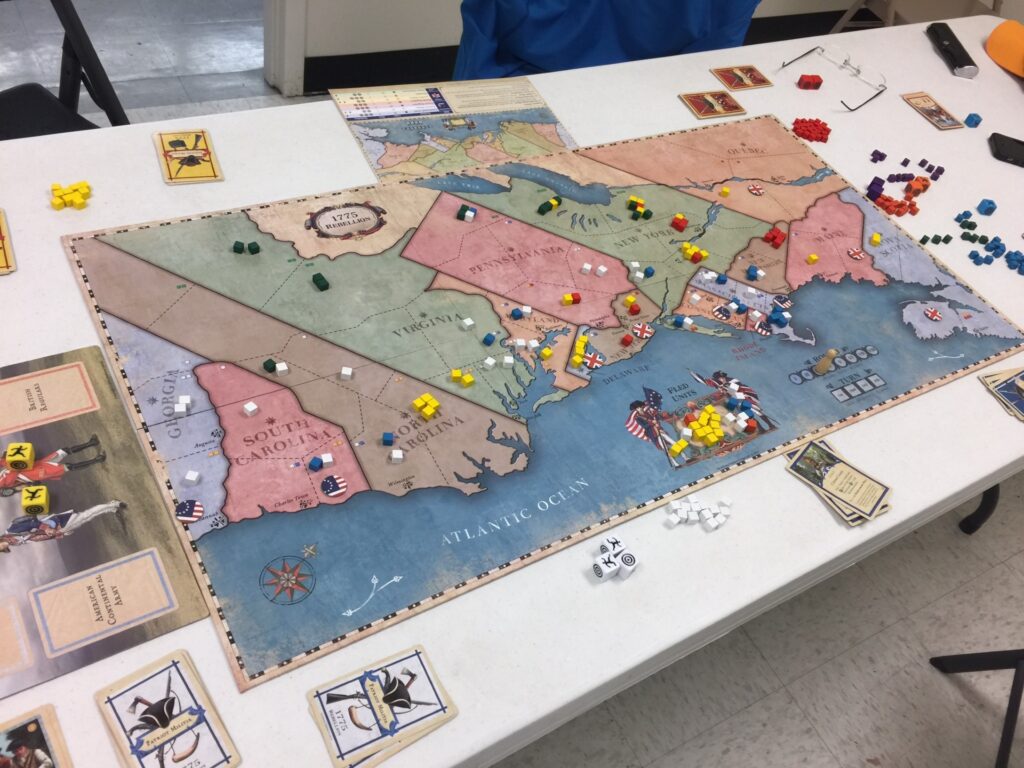
1775: Rebellion, Jeph Stahl & Beau Beckett
Works Cited
Bharadvaj, Akar. “Building a new generation of wargame professionals with intention: From Avalon Hill to Oregon Trail and beyond,” in PAXisms, 30 June 2023, https://paxsims.wordpress.com/2023/06/30/building-a-new-generation-of-wargame-professionals-with-intention-from-avalon-hill-to-oregon-trail-and-beyond/. Accessed on 22 January 2024.
Board Game Geek, https://boardgamegeek.com/
Guglielmo, Thomas A.. Divisions: A New History of Racism and Resistance in America’s World War II Military. New York: Oxford University Press, 2021.
Herman, Mark. “Empire of the Sun: The Next Evolution of the Card-Driven Game Engine,” in Pat Harrigan and Matthew G. Kirschenbaum (eds.) Zones of Control: Perspectives on Wargaming. Cambridge: The MIT Press, 2016.
Peterson, Jon. Playing at the World: A History of Simulating Wars, People, and Fantastic Adventures, from Chess to Role Playing Games. San Diego: Unreason Press, 2012.
Thompson, David. Design Diary: Platoon Command, Board Game Geek, 12 May 2016, https://boardgamegeek.com/thread/1574688/design-diary?fbclid=IwAR3HreVAW-rIkG5ReC17_BQyKtwQNe9Seu9gqsmFzEe0B4T-rBaetFOJdfc. Accessed 19 September 2023.
San José State University. The History of the Development of Libyan Gas and Oil Reserves. https://www.sjsu.edu/faculty/watkins/libyanoil.htm. Accessed 13 September 2023.
Suckling, Maurice. “The Re-Popularization of Commercial Wargames”, Ludogogy, 8 November 2020, https://ludogogy.co.uk/article/the-re-popularization-of-commercial-wargames/. Accessed on 22 January 2024.
U.S. Deputy Secretary of Defense, Memorandum for Director, Cost Assessment and Program Evaluation, Warfighting Lab Incentive Fund and Governance Structure. 6 May 2016, https://defenseinnovationmarketplace.dtic.mil/wp-content/uploads/2018/02/DSD_memo.pdf. Accessed on 22 January 2024.
United States Accountability Office. Report to the Committee on Armed-Services, House of Representatives. Defense Analysis: Additional Actions could enhance DOD’s Wargaming Efforts. April 2023, https://www.gao.gov/assets/gao-23-105351.pdf. Accessed on 22 January 2024.

Dr. Cody Carlson
College of Western Idaho
Cody Carlson holds a PhD from the University of North Texas’ Military History Center. He currently teaches at the College of Western Idaho, and his research focus is the United States Army in the Second World War. He also runs the tabletop game review YouTube channel, The Discriminating Gamer.
